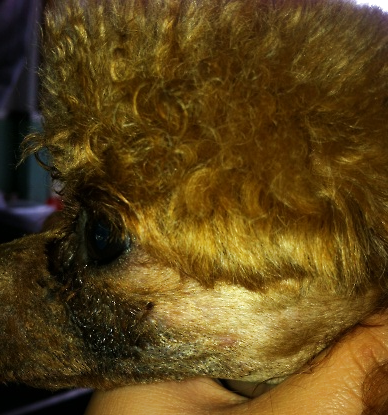1. Overview of canine skin diseases
Canine skin diseases occur in various time periods, and there are many types and causes. Compared with other types of diseases such as infectious diseases, skin diseases have a higher incidence and are one of the more common diseases. However, because skin diseases have little impact on dogs themselves
2. The cause of the disease
There are many etiologies of canine skin diseases, including non-pathogenic and pathogenic factors.
2.1 Pathogenic factors
The parasitic skin diseases among the pathogenic factors are roughly divided into lice, mites, fleas, etc. The mites are caused by parasitic mites in the hair follicles and sebaceous glands of dogs and cats in the stratum corneum of the cortex.
2.2 Non-pathogenic factors
Non-pathogenic factors include skin diseases such as seborrheic dermatitis caused by genetic factors caused by different dog breeds; lack of trace elements caused by insufficient nutrition in dog food; poor self-sanitation of dogs or long-term dark and humid conditions.
3. Symptoms and Diagnosis
3.1 Clinical symptoms
3.1.1 Fungal skin diseases
The main symptoms of fungal skin diseases are increased dandruff, the formation of large and small irregular hair loss areas locally or on the whole body, and occasional severe itching, etc.
3.1.2 Bacterial skin diseases
Bacterial skin diseases are generally accompanied by pyoderma, which is characterized by inflammatory exudation under the skin [3], the surface of the lesions is shed, and the exudation forms crusts on the surface.
3.1.3 Parasitic skin diseases
Parasitic skin diseases are characterized by hair loss, itching, and scratching and biting in sick dogs. Parasites such as Demodex can also cause scabs and pyoderma.
3.1.4 Seborrheic skin disease
Dogs with seborrheic dermatosis will emit a strong oily smell, incomplete skin keratinization, and many white bran-like dander or tawny oil-like dander between the hairs [4].
3.2 Diagnostic methods
3.2.1 Diagnosis of fungal skin diseases
For fungal skin diseases, local or whole body hair loss areas and a large number of dandruff can be found in the clinical examination, and then the Wood's lamp is used to examine in the dark, and the fungal infection can be determined by the fluorescence reaction displayed.
3.2.2 Diagnosis of parasitic skin diseases
Parasitic skin diseases can be obtained by scraping the affected area of the dog until there is slight oozing of blood. The scraped dog skin tissue and hair can be examined by microscopy. If the microscopic examination shows adult mites or larvae or egg feces, the diagnosis can be made.
3.2.3 Diagnosis of bacterial skin diseases
Bacterial skin diseases need to observe the diseased part of the dog, and judge by its manifestations such as papules, pustules, etc.
3.2.4 Diagnosis of seborrheic skin disease
Usually, dogs with seborrhea have a special smell, and the seborrheic characteristics are obvious in the coat skin, and the greasy feeling is heavy.
For the skin disease investigation in Wuxi Anmei Pet Hospital, about 50 cases of dogs were investigated successively. First, the pets were clinically examined for canine skin disease. After finding that the examination could not fully reflect the real cause, fluorescence reaction and skin scraping microscopy were carried out.
Table 1 Investigation and analysis results of infection rate and infection types of canine skin diseases
| Canine skin disease types | Number of dogs (only) | Infection rate (%) |
| Fungal skin disease | 11 | 22 |
| Bacterial skin diseases | 4 | 8 |
| Parasitic Skin Disease | 7 | 14 |
| Seborrhea | 3 | 6 |
I have diagnosed many cases of skin diseases and found that there are many reasons for canine skin diseases, which are mainly divided into the following reasons: fungal skin diseases caused by spores; bacterial skin diseases caused by Staphylococcus aureus;
During the internship in the pet hospital, the skin disease examination of dogs generally includes ultraviolet fluorescence reaction, skin scraping sampling examination, etc.
Table 2 Types of canine skin diseases and the results of investigation and analysis
| Types of canine skin diseases (number of dogs) | Causes | |||
| Contact with sick dogs (only) | Grass Infection (only) | Lots of meat (only) | Other (only) | |
| Fungal skin diseases (11) | 2 | 7 | 0 | 2 |
| Bacterial skin diseases (4) | 0 | 2 | 0 | 2 |
| Parasitic skin diseases (7) | 2 | 3 | 0 | 2 |
| Seborrhea (3) | 0 | 0 | 2 | 1 |
4.1.1 Fungal skin diseases
At the time of the onset, the dog's coat fell off, forming obvious ringworm spots, small red spots on the surface, severe itching, and the sick dog kept scratching until the skin oozing, as shown in Figure 2.3.1
4.1.2 Bacterial skin diseases
Bacterial skin disease manifests skin swelling, swelling, crusting and hardening; parasitic skin disease, milder hair loss, severe skin papules, skin and tissue nodules, and pustules
4.1.3 Parasitic skin diseases
During the onset of parasitic skin disease, the hair on the lesion will fall off, the skin will appear keratinized, and the dandruff will increase as shown in Figure 2.3.3.
4.1.4 Seborrheic skin disease
Seborrheic skin disease has a special smell, the smell of oil is very serious, and the texture of the coat is also relatively greasy.
Figure 2.3.5, Figure 2.3.6
Figure 2.3,1 Fungal skin disease

Fig. 2.3,2 Parasitic skin diseases
Figure 2.3,3 Demodex
Figure 2.3,4 Demodex
Fig. 2.3,5 Seborrhea
Fig. 2.3,6 Seborrhea
5. Summary
Generally speaking, the main skin diseases of dogs are roughly divided into four categories, parasitic skin diseases, seborrheic skin diseases, bacterial skin diseases, and fungal skin diseases.
